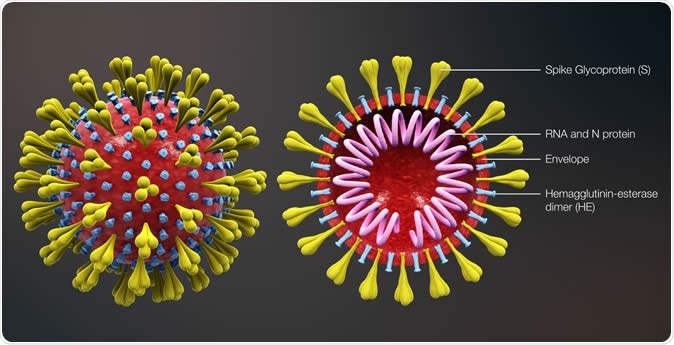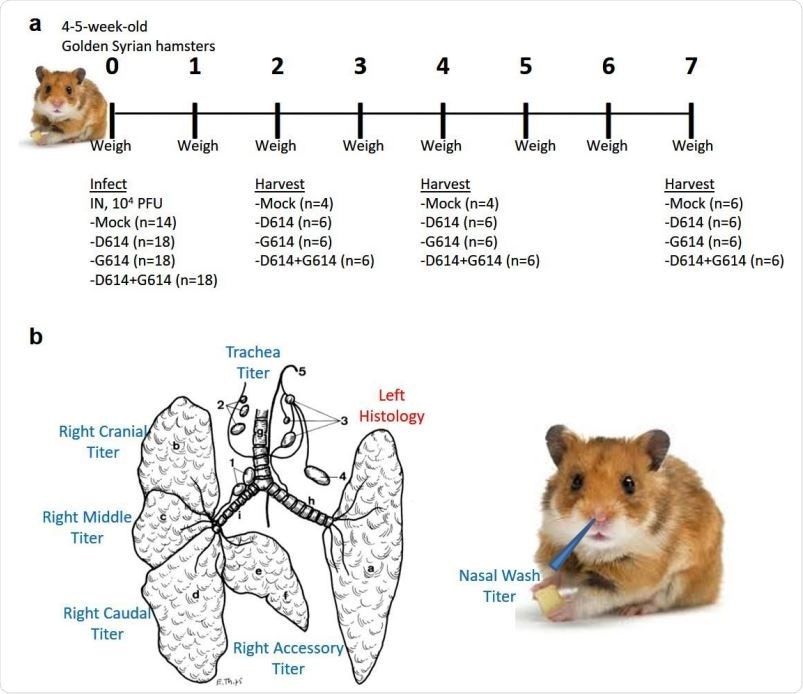As the COVID-19 pandemic progresses, it is crucial to track the viral changes in order to link the clinical and epidemiological features of the disease with these mutations. A new study published on the preprint server bioRxiv* in September 2020 reports on a common severe acute respiratory syndrome coronavirus 2 (SARS-CoV-2) mutation, D614G, and its effects on the virus.
Early in the course of the pandemic, a new mutation emerged, namely, D614G, in the spike protein, superseding most local strains wherever it appeared. The current study is based on incorporating this mutation into a wildtype SARS-CoV-2 strain in order to understand how it affects virus-host interactions.
The outcomes they measured included viral replication on human lung epithelial cells and primary human airway tissues, viral fitness in hamster upper airway, and neutralization susceptibility. This study should contribute to understanding the role played by this mutation in the transmission of the virus, the effectiveness of various vaccines, and of convalescent antibody-rich plasma.

Spike Mutations and Their Importance
Even though most COVID-19 cases develop mild illness only, the pandemic has claimed almost 900,000 lives worldwide in the last eight months. Notably, severe COVID-19 is linked to dysregulated immune response, with excessive and systemic inflammation. However, viral factors such as virulence could also play a part in the evolution of the illness.
Researchers have discovered mutations that encode amino acids of a different sort in the SARS-CoV-2 spike protein sequence. This protein is key for viral entry into the host cell via the angiotensin-converting enzyme 2 (ACE2). Such mutations may cause alterations in the host range, pathogenesis and tissue tropism.
In the earlier SARS outbreak of 2002, a single mutation in the spike protein allowed the infection to spill over from the original reservoir to the intermediate civet host and to humans.
The D614G Mutation
In the current pandemic, the D614G mutation has become dominant after March, to cover ~75% of all published viral sequences by June 2020. There were three accompanying mutations as well.
This mutation set has become the predominant one both worldwide and also within distinct localities after introduction, showing that it may have conferred a fitness advantage and not just due to the founder effect or genetic drift. One especial advantage appears to be increased infectious potential, supported by the finding that this mutant is associated with higher viral loads in the nasopharynx in COVID-19 patients.
Pseudoviruses Show Improved Infectivity of Mutant Strain
Transmissibility is a key factor in viral fitness, but direct measurements were required to confirm the role of the mutation in improved fitness. The researchers first described the phenotype of the D614G mutation in pseudoviruses. They found higher viral titers in many different types of cell cultures when infected by the G614 variant. This indicated that perhaps the variant could cause higher viral entry into cells and replication in the airway.
To confirm this, they used wildtype virus with the spike mutation to infect a cell culture, primary human airway 3D tissue, and experimental hamsters. They also used neutralization tests for serum samples and monoclonal antibodies (mAbs), based on reporter SARS-CoV-2 viruses carrying either D614 or G614, labeled with mNeonGreen.

Higher Replication and Infectivity of Mutant Strain
The researchers observed that the D614G substitution in the spike protein in human lung epithelial cells caused more significant viral replication and infectivity by comparing the two variants, first in Vero cell culture. They found similar-looking plaques, but with a higher infectious titer with the G614 virus after 12 hours; later, both displayed similar titers. The same was seen for extracellular viral RNA loads. This showed that the mutation did not affect these two parameters on Vero cells.
The next step was to repeat the experiment on human lung epithelial Calu3 cells. They found that the G614 virus had somewhat higher infectious viral titers up to a maximum of 2.4 times higher over the next 48 hours. Still, the viral RNA load was lower or equivalent over the same period with this variant. This indicates that the D614G mutation makes the virus in the human lung cell line more infectious.
How did this happen? To know more, the researchers then looked at how the spike protein was being processed in the two variants. They found that full-length spike protein obtained from the virions grown in human lung epithelial cells was almost fully processed to the cleavage form in both variants. However, those obtained from Vero cells showed markedly lower cleavage efficiencies by 20% and 30% less for the D614 and G614, respectively.
This suggests the influence of the cell culture on the cleavage efficiency, but no differential effect was observed between the two viruses.
Mutation Improves Fitness in Hamster Upper Airway
The D614G mutation was then tested in the golden Syrian hamster model, where it was found that either variant showed similar pathological features, including weight loss, but without other visible symptoms. The infectious viral titers from the upper and lower respiratory tract were similar for both viruses on the second day, but the differences were more apparent in the upper than the lower airway. The most significant difference between the titer of infectious virus for the two variants was seen on day 4 after infection, in the upper airway, particularly in the nasal epithelium.
Even though the infectious viral titer was higher for G614 than for D614 in hamsters, the viral RNA load was almost identical. Thus, the ratio of RNA to PFU for G614 remained lower across the range of airway tissues.
The researchers' comment, “If the lower viral RNA/PFU ratio of the G614 virus could be extrapolated to COVID-19 patients, the modest differences in cycle threshold (Ct) values of RT-qPCR in patients’ nasopharyngeal swabs would translate to ≥10-fold infectious G614 virus, underscoring the potential for enhanced transmission and spread.” In fact, it has been observed that if the same patient has two different strains, one in throat swabs and the other in sputum, the former alone is the cause of spread.
On the seventh day after infection, no infectious virus could be detected. However, viral RNA copies were still abundantly found in nasal wash samples, indicating that viral RNA persists after the infectious virions are cleared. This explains positive RT-PCR findings in some COVID-19 patients, even when the infectious virus is undetectable. Moreover, it reflects the clinical finding that disease severity is not correlated with the dominant mutation.
Direct fitness comparison was carried out using a competition experiment. This allows the elimination of host-host variations while using internal controls, with more precise quantification of the ratio of the virus strains than comes from finding the titers individually. Using intranasal inoculation, they infected hamsters with 104 PFU each for each virus. To compensate for the Vero cells of origin, they were also given viral RNA to levels equivalent to the above. They found that in all airway tissues, the G614 virus is superior to D614G614/D614, indicating its replication advantage.
Viral Replication Boosted
The researchers then evaluated the replication of D614 and G614 viruses in a 3D primary airway tissue model. They found that titers of infectious virus were much higher for the latter, at 2-8 times, but not the viral RNA loads. This confirms the effect of the substitution on replication by increasing viral replication in the human upper airway tissue.
Competition experiments to compare replication fitness showed that even when the initial infectious ratio of D614 and G614 went from 1:1 to 9:1, the latter still increased to fivefold the infectious viral titer of the former within five days. The G614 strain can thus outperform the other at great speed to achieve the numerical advantage, even when it is first present as the minor variant in a mixed virus population.
Susceptibility to Neutralization
The neutralization testing of a set of sera collected from hamsters that had been infected with the D614 strain showed that in all cases, the neutralization titer required for G614 was 1.4- to 2.3 times higher than for D614, showing that this mutation may increase the susceptibility to neutralization. Thus, any vaccine effective against the former will not lose its efficacy against the latter.
The researchers then looked at 11 anti-RBD mAbs against the two viruses. They found that only one showed double the potency against G614 compared to D614, but the other 10 showed similar neutralization efficacy to both. The mutation may reduce the neutralization efficacy depending on the conformation of the spike protein, based on which epitope is presented to the mAb.
Conclusion
The researcher sum up their findings as demonstrating that “spike substitution D614G enhances viral replication in the upper respiratory tract and increases neutralization susceptibility.” This could help develop better vaccines and antibodies to contain the pandemic in the future. (written By Dr. Liji Thomas, MD)
*Important Notice
bioRxiv publishes preliminary scientific reports that are not peer-reviewed and, therefore, should not be regarded as conclusive, guide clinical practice/health-related behavior, or treated as established information.
- Plante, J. A. et al. (2020). Spike Mutation D614G Alters SARS-Cov-2 Fitness And Neutralization Susceptibility. bioRxiv preprint. doi: https://doi.org/10.1101/2020.09.01.278689. https://www.biorxiv.org/content/10.1101/2020.09.01.278689v1





